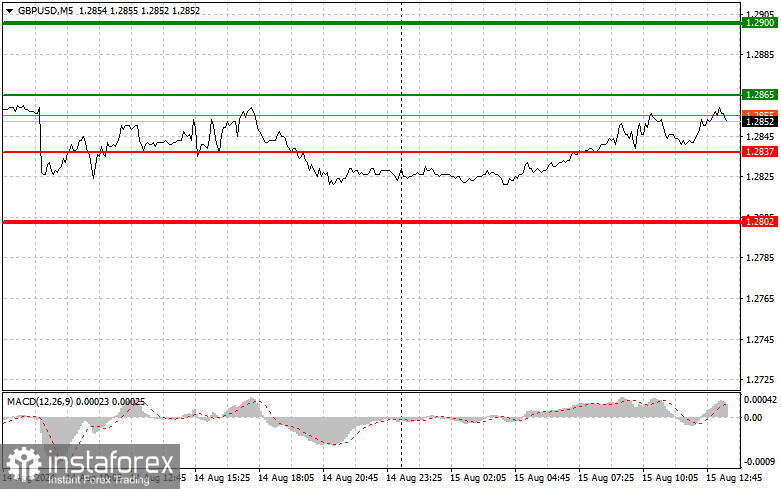Analysis of Trades and Tips for Trading the British Pound
The test of the 1.2844 level occurred when the MACD indicator moved significantly above the zero mark, limiting the pair's further upward potential. Given the lack of reaction to reasonably strong UK GDP data and another test of 1.2844, I decided to sell the pound. Unfortunately, there was no significant downward movement, so after another breach of 1.2844, I decided to exit the market with minimal losses. This afternoon, everything will start with the release of U.S. retail sales data and end with reports on initial jobless claims, the Empire Manufacturing Index, the Philadelphia Fed Manufacturing Index, and industrial production. Weak statistics could give the pound a chance to rise against the dollar, as could dovish statements from FOMC member Patrick T. Harker. For the intraday strategy, I plan to follow either Scenario No. 1 or Scenario No. 2.

Buy Signal
Scenario No. 1: Today, I plan to buy the pound when the price reaches around 1.2865 (green line on the chart) with a target of rising to 1.2900 (thicker green line on the chart). At the 1.2900 level, I will close the purchases and open short positions in the opposite direction (expecting a move of 30-35 points back down from the level). The pound is likely to rise today if the U.S. statistics are weak. Note: Before buying, make sure that the MACD indicator is above the zero mark and is just starting to rise.
Scenario No. 2: I also plan to buy the pound today if there are two consecutive tests of the 1.2837 price level when the MACD indicator is in the oversold area. This will limit the pair's downward potential and lead to an upward market reversal. A rise to the resistance levels of 1.2865 and 1.2900 can be expected.
Sell Signal
Scenario No. 1: I plan to sell the pound today after the level of 1.2837 (red line on the chart) is updated, which will lead to a quick decline in the pair. The key target for sellers will be the 1.2802 level, where I will close the short positions and immediately open long positions in the opposite direction (expecting a move of 20-25 points back up from the level). Sellers are likely to become active if the U.S. retail sales data shows strong growth. Note: Before selling, make sure that the MACD indicator is below the zero mark and is just starting to decline.
Scenario No. 2: I also plan to sell the pound today in case of two consecutive tests of the 1.2865 price level when the MACD indicator is in the overbought area. This will limit the pair's upward potential and lead to a downward reversal. A decline to the support levels of 1.2837 and 1.2802 can be expected.

Chart Explanation:
- Thin green line: The entry price at which the trading instrument can be bought.
- Thick green line: The projected price where you can set Take Profit or manually lock in profits, as further growth above this level is unlikely.
- Thin red line: The entry price at which the trading instrument can be sold.
- Thick red line: The projected price where you can set Take Profit or manually lock in profits, as further decline below this level is unlikely.
- MACD Indicator: When entering the market, it is important to use overbought and oversold zones.
Important: Beginner traders in the Forex market should be very cautious when making market entry decisions. Before important fundamental reports are released, it's best to stay out of the market to avoid sudden price swings. If you decide to trade during news releases, always set stop-loss orders to minimize losses. Without stop-loss orders, you can quickly lose your entire deposit, especially if you don't use money management and trade in large volumes.
Remember, to trade successfully, you need a clear trading plan, like the one I presented above. Spontaneous trading decisions based on the current market situation are generally a losing strategy for an intraday trader.
 English
English 
 Русский
Русский Bahasa Indonesia
Bahasa Indonesia Bahasa Malay
Bahasa Malay ไทย
ไทย Español
Español Deutsch
Deutsch Български
Български Français
Français Tiếng Việt
Tiếng Việt 中文
中文 বাংলা
বাংলা हिन्दी
हिन्दी Čeština
Čeština Українська
Українська Română
Română

